Theresa Weber: Cycles of Unmasking
For her first public commission in the UK, London-based artist Theresa Weber produces a site-specific installation responding to the history and architecture of Somerset House.
Archived Event
| Dates | 21 Jun 2023 - 01 Feb 2024 |
| Space | Stamp Stair South Wing |
| Price | Free |
Theresa Weber explores non-hierarchical relationships between histories and narratives in this new installation.
Located in the stairwell of the Stamp Stairs of the South Wing at Somerset House, the work aims to connect the building’s levels in new ways and stand as a counterpoint to the hierarchical and complex relations drawn from Somerset House’s centuries-long history.
Unpicking the embedded imperial narratives encoded in the vertical passageway of the building, Weber’s commission draws on a variety of critical perspectives and mythological references including Poseidon, Caribbean Carnival, and medicinal plants to form an anti-monumental, entangled sculpture that hangs and branches out across the stairwell. The installation also features a wall-based artwork made of resin that incorporates these thematic elements and symbols.
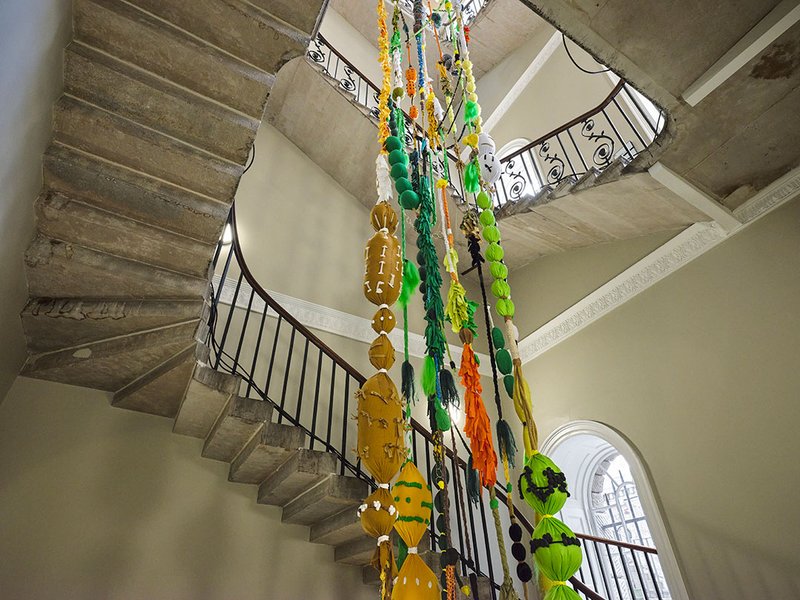
Theresa Weber (b. 1996, Germany, Düsseldorf) is a German-Jamaican-Greek artist, who lives and works in London. She completed an MA in Sculpture at the Royal College of Art, London and her work has most recently featured in ‘Studio Response [#3]’, Saatchi Gallery, London (2022/23) and Bloomberg New Contemporaries, South London Gallery (2022).
Q&A with Theresa Weber
What was your inspiration for this project?
I first asked myself, ‘how can I be critical of colonial spaces, while also uncovering the potential for healing to be contained within them?’ The architecture of Somerset House can be quite overwhelming. The inspiration for the sculptures were natural, organic forms: liana vines, root networks, and medicinal plants, that I could juxtapose against the static, man-made architecture of Somerset House. Conceptually, I was very inspired by the writing of Édouard Glissant and his use of natural motifs to describe complex diasporic realities. Sculpturally, I took inspiration from traditional community-based gestures such as weaving, braiding, and wrapping. I was also inspired by the physicality of the Stamp Stairwell as a formal analogy for the spiral progression of ‘deep time’. For me, this is a poetic means of entering into a consideration of time at the largest scale: the eternal spiral of time that encloses all of us and connects us all to the deepest sources of life. This is also where the Cycles of … in the title is rooted.
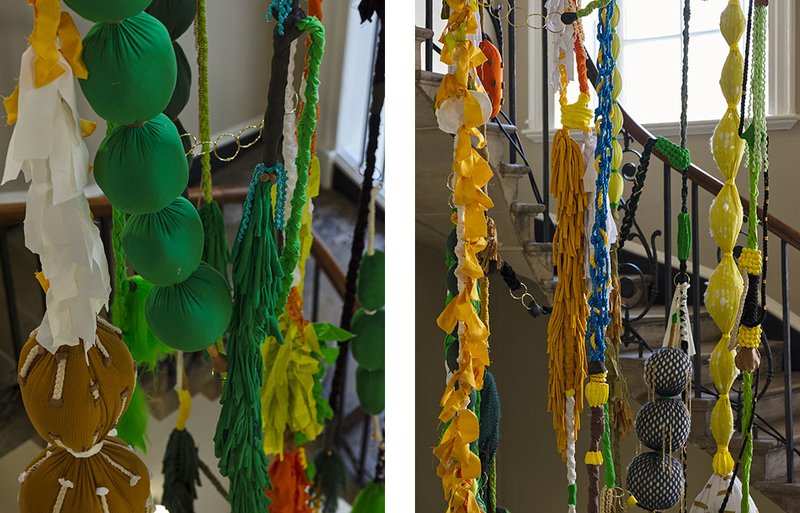
How have you responded to the history and architecture of the site?
What stood out to me was the way that hierarchies of power were specifically designed into the building. This is why I chose to work with the Stamp Stairwell, which develops from a very rough and cheap finish downstairs where the staff used to work, toward a polished and decorated design upstairs for the upper class. The sculpture that I developed seeks to oppose the hierarchy defined by the different levels of the stairway. The subtitle of the work, Entanglements, not only visually describes the sculpture’s organic form, but also speaks to the complex relations between coloniser and colonised that are inextricably woven into the fibre of history.
Another aspect of my historical research was the history of Masque Balls that took place at Somerset House, starting with the ‘Masque of Blackness’ in 1605. These masquerades included costumes designed by Inigo Jones, who took inspiration from the cultures of people colonised by the British empire, and from their mythologies. A prominent feature of the Masque of Blackness was the use of blackface by attendees. I am attempting to reclaim that history by taking as the Caribbean Carnival as inspiration, and the continual reinvention of empowerment it represents within creole cultures. This is where …Unmasking in the title comes from.
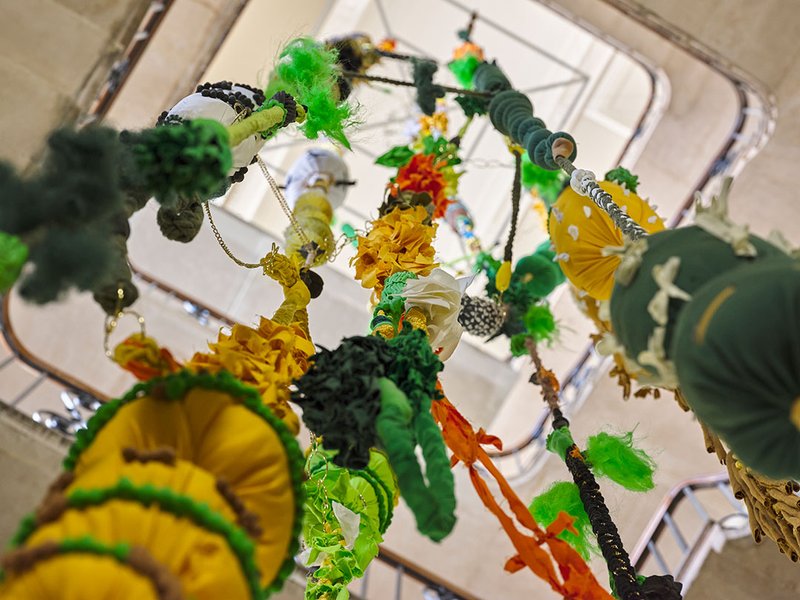
Could you describe some of the histories and symbols included in the works?
The wall-based work Cycles of Unmasking - Fracture, which is located next to the sculpture, is meant to be an archival collage and mind map that depicts my narrative for this project. Its arrangement is non-hierarchical. A few examples of included references are: prints of historical drawings depicting the masquerade costumes, an historical drawing of nobles in blackface, some of my sketches, the deep time spiral, Caribbean carnival costumes, healing plants and physical costume materials. Another motif that comes up is the visage of Poseidon, which is located on the river side façade of Somerset House as well as other locations. For me, the Greek God of Water refers to the role that oceans plays within imperial history.
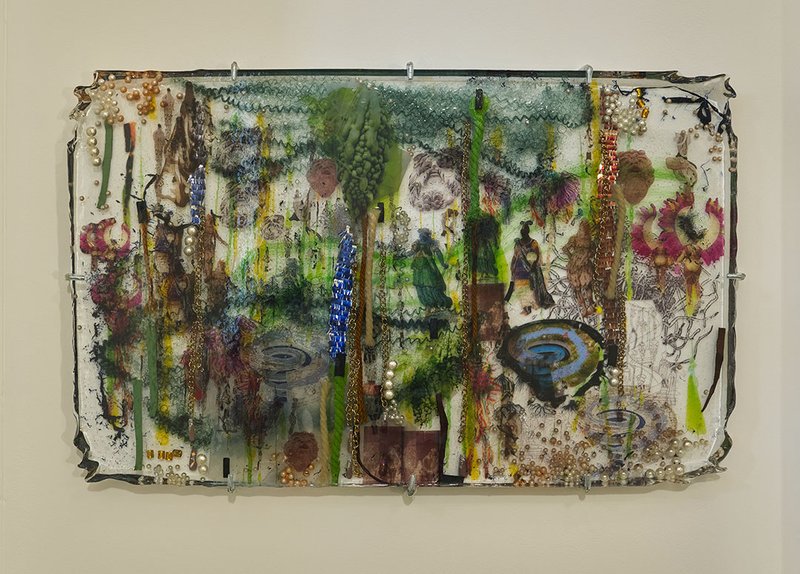
What materials have you used for the stairwell installation, and how do these relate to the themes of the works?
The sculpture is largely composed of what I consider to be costume materials: fabric, rope, modelling mass and smaller elements such as jewellery. This is a reference to the history of the Caribbean Carnival as a way of subverting the history of the traditional Masque Ball. The sculptural shapes are nature inspired, so my colour-palette is vibrant, but earthy at the same time, including greens, brown, yellow, orange, and turquoise.
Could you describe the conversation between the three parts of Cycles of Unmasking?
The three elements that I developed for this concept are the large-scale sculpture in the Stamp Stairs, the wall-based piece next to it, and the collaborative performance with sound artist Nathanael Amadou Kliebhan and two performers, Alïn-Sitoé Diallo and Joy Yaa Kincaid. As my goal is to emphasize a healing approach, I chose to activate the work through a ritualistic performance that makes use of sound and movement to bring people together. The performance takes place on the Summer Solstice, which spiritually is a day of inner healing and the perfect balance between day and night. Nathanael´s sound work will also be site-specific, as he is using recordings of the Thames that flows next to the building and echoes of the space. The wall-based piece seeks to translate the conceptual narrative of the works to the visitors. It allowed me to provide the viewer with a deeper insight into my thought process, and to show my specific research materials through, for example, the inclusion of preparatory sketches.
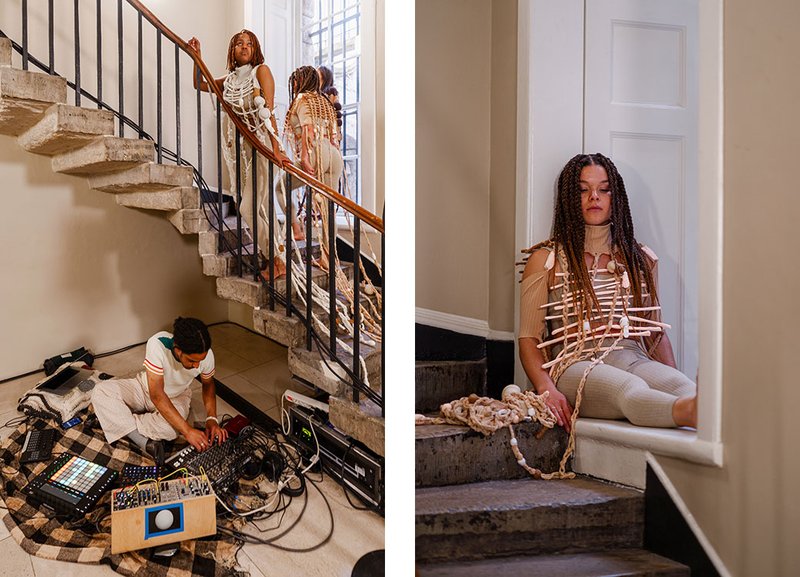
Sponsored by

Installation photography by Reinis Lismanis
Performance photography by Anne Tetzlaff